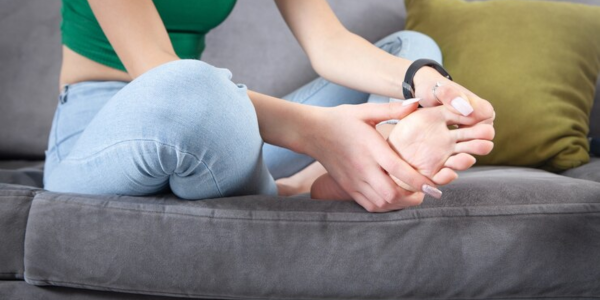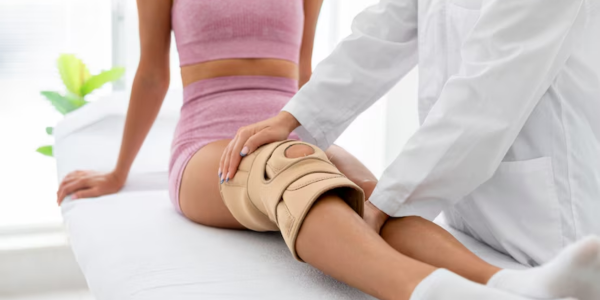Why Lymph Nodes Swell in Feet and Legs | Causes, Symptoms & Treatment
Why Lymph Nodes Swell in Feet and Legs: Causes, Symptoms, and What You Should Know

When most people think of swollen lymph nodes, they picture the neck, underarms, or groin. But when swelling strikes in the feet or legs, and lymph nodes are involved, it often raises questions and concerns.
Swollen lymph nodes in the feet and legs aren’t just uncomfortable. They can be a signal from your body that something more serious is going on beneath the surface.
Whether it’s infection, inflammation, or a chronic condition like lymphedema, understanding the “why” behind this swelling is crucial.
In this article, we’ll break down:
- What lymph nodes actually do
- Where leg and foot lymph nodes are located
- The most common causes of lymph node swelling in the lower extremities
- Symptoms to watch for
- Diagnosis and treatment options
- When to see a doctor
Let’s get into it.
What Are Lymph Nodes And Why Do They Swell?
Lymph nodes are small, bean-shaped structures that act like filters for your immune system. They’re scattered throughout your body and are part of the lymphatic system, which moves lymph, a clear fluid containing white blood cells through a network of vessels.
Their job? Trap viruses, bacteria, and other harmful substances so your immune system can destroy them. When lymph nodes detect trouble, they ramp up activity, which often makes them swell.
Swelling in lymph nodes (medically called lymphadenopathy) typically occurs near the site of an infection or issue.
If your feet or legs are inflamed, injured, or infected, nearby lymph nodes especially in the inguinal (groin) or popliteal (behind the knee) region may swell.
Where Are Lymph Nodes Located in the Legs and Feet?
You won’t find lymph nodes directly in the feet, but several key groups of lymph nodes drain the lower limbs:
1. Popliteal Lymph Nodes
- Location: Behind the knees
- Function: Drain lymph from the lower leg and foot
- Popliteal lymph Nodes were swelling here may indicate localized infections or inflammation in the feet or lower legs.
2. Inguinal Lymph Nodes
- Location: Groin area
- Function: Receive lymph from the entire leg, genitals, and lower abdomen
- Inguinal Lymph Nodes are the most commonly enlarged nodes when there’s an issue in the legs or feet.
Why Do Lymph Nodes Swell in the Feet and Legs?
Let’s explore the major culprits.
1. Infections
Infections are the number one cause of swollen lymph nodes especially in the lower limbs. Here are the most common types:
-
Cellulitis
This is a bacterial skin infection that often starts with a break in the skin. Redness, warmth, pain, and swelling are common and it can quickly lead to swollen nodes in the groin or behind the knee.
-
Fungal Infections
Conditions like an athlete’s foot can trigger immune responses. If untreated, the infection can spread, causing nearby lymph nodes to swell.
-
Wounds or Ulcers
Cuts, insect bites, or ulcers especially in people with diabetes can become infected. This localized infection is enough to activate nearby lymph nodes.
-
Sexually Transmitted Infections (STIs)
Certain STIs like herpes or syphilis may cause swelling of the inguinal lymph nodes, especially if they involve the genitals or lower abdomen.
2. Lymphedema
Lymphedema is swelling caused by a blockage or dysfunction of the lymphatic system. It can lead to fluid buildup in tissues, usually in the arms or legs.
- Primary lymphedema is rare and inherited.
- Secondary lymphedema is more common and often caused by:
- Cancer or radiation treatment
- Surgical removal of lymph nodes
- Severe infections or trauma
Over time, chronic lymphedema can cause hardening of tissues and further strain the lymphatic system, which may enlarge lymph nodes.
3. Cancer
Lymph nodes can swell due to cancer in several ways:
-
Lymphoma
This cancer starts in lymphocytes (a type of white blood cell). It can cause painless, firm swelling in lymph nodes including those in the groin.
-
Metastatic Cancer
Cancers from elsewhere in the body (e.g., testicular, cervical, or skin cancers like melanoma) can spread to lymph nodes in the legs or groin.
4. Venous Insufficiency and Lymphatic Overload
Chronic venous insufficiency (CVI) is a condition in which the leg veins struggle to send blood back to the heart. The resulting fluid buildup can overwhelm the lymphatic system, leading to:
- General swelling in the legs
- Increased pressure on lymph nodes
- Potential lymph node enlargement
5. Autoimmune Conditions
Diseases like lupus or rheumatoid arthritis cause systemic inflammation, which can trigger reactive lymph node swelling even in the lower limbs.

Symptoms to Watch For
If your lymph nodes are swelling in your legs or feet, the symptoms might include:
- A firm or tender lump in the groin or behind the knee
- Swelling in the foot, ankle, or calf
- A sensation of heaviness or tightness
- Warm, red skin near the swollen area
- Skin infections or ulcers that heal slowly
- Fever or fatigue (if the cause is systemic)
Don’t ignore swelling that comes on suddenly, is painful, or continues to worsen.
How Are Swollen Lymph Nodes in the Legs Diagnosed?
A proper diagnosis starts with a physical exam and medical history, but your doctor may also use:
- Ultrasound or Doppler imaging to view blood flow and lymph node structure
- MRI or CT scans to check for deep lymphatic blockages or tumors
- Blood tests to identify infections or autoimmune markers
- Lymphoscintigraphy to trace lymphatic flow
- Biopsy if cancer is suspected
The goal is to find the underlying cause, not just treat the symptom.
Treatment Options
How swollen lymph nodes in the legs and feet are treated depends entirely on what’s causing them.
If It’s an Infection:
- Antibiotics for bacterial infections like cellulitis
- Antifungal creams or pills for fungal issues
- Wound care for cuts or ulcers
- Proper foot hygiene to prevent recurrence
If It’s Lymphedema:
- Compression therapy using stockings or wraps
- Manual lymphatic drainage (a type of massage therapy)
- Exercise to stimulate lymph flow
- Skin care to prevent infection
- Pneumatic compression devices in more severe cases
If It’s Cancer:
- Surgery to remove affected lymph nodes or tumors
- Chemotherapy or radiation depending on cancer type
- Immunotherapy for certain lymphomas
If It’s an Autoimmune Disease:
- Immunosuppressive drugs like corticosteroids
- Anti-inflammatory medications
- Lifestyle adjustments like diet and stress management
Can You Prevent Swollen Lymph Nodes in the Legs?
You can’t control every factor, but you can reduce your risk by:
- Keeping your feet and legs clean and free from infection
- Wearing properly fitted footwear to avoid skin damage
- Managing chronic conditions like diabetes and high blood pressure
- Staying active to promote healthy circulation
- Elevating your legs if you stand for long hours
- Maintaining a healthy weight
- Avoiding tight clothing that restricts lymph flow
If you’ve had cancer treatment or lymph node surgery, work with a lymphedema specialist to prevent complications.
When to See a Doctor?
Make an appointment if you notice:
- A swollen node that lasts more than 2 weeks
- A node that is hard, fixed, or growing rapidly
- Painful swelling with fever or signs of infection
- Red streaks near the area (possible sign of lymphangitis)
- Unexplained leg swelling or skin changes
These symptoms might signal something serious and catching it early makes a big difference.
Final Thoughts
Swollen lymph nodes in the feet and legs should never be ignored. While they can result from something as simple as a minor infection, they may also point to more serious conditions like lymphedema, autoimmune disorders, or even cancer.
These nodes are part of your immune system’s frontline defense, and when they swell, it’s usually because they’re reacting to a threat.
Persistent or unexplained swelling, especially when accompanied by pain, skin changes, or systemic symptoms like fever, is a signal that your body needs medical attention.
Early diagnosis is key to effective treatment, and getting the right care can prevent complications down the line. If you’re experiencing leg or foot swelling and aren’t sure why, don’t wait consult a healthcare provider to get to the root of the problem.
.